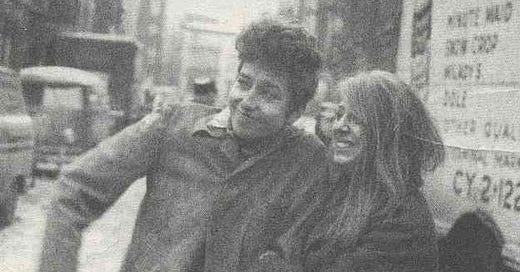Suze Rotolo, John Lee Hooker, and Another Dude
"Whenever John was around, I would talk with him. And when Bob and I got together, the friendship expanded."
When I interviewed John Lee Hooker in 1992, the bluesman was on a roll, with a recent Grammy, a hit album (The Healer), and a 1991 induction into the Rock and Roll Hall of Fame. Hooker had a new album out, Mr. Lucky, which is why I was interviewing him, for Musician. It was a phoner; I was in my office in New York and John was in a hotel in San Francisco. Which struck me as odd; he owned homes in Los Altos and Redwood City, both of which are less than an hour’s drive from San Francisco. (Hooker knew how to handle money, and hired others who did, too; he wound up owning five homes.) The great bluesman, who was either 80, 77, 75, 72, or 69, depending on which bluesologist you listened to, was layin’ up in bed watching two baseball games at the same time, on two TVs. He was a sharply-focused man, easily able to keep track of two baseball games while handling my questions.
John Lee Hooker had his own, immediately identifiable sound, which doesn’t mean that he didn’t keep a close ear on trends, adapting accordingly. In the late 1950s, with the folk revival getting underway, John put down his electric guitar, put his band on extended leave, picked up an acoustic, and cut the 1959 album The Country Blues of John Lee Hooker. Which is how Hooker and Suze Rotolo came to cross paths.
A politically aware teenager from Queens, Suze (that’s Soo-zee, two syllables) joined Bayard Rustin’s Youth March for Integrated Schools, which held its meetings next door to a record store on 125th Street. “Before climbing the stairs to Youth March headquarters,” Rotolo writes in A Freewheelin’ Time, her 2008 memoir, “I would stop by the record store, a small, narrow place full of albums in wooden bins where the owner always had a record playing. One day as I walked in, I heard music that stopped me in my tracks. It was as if the store were suddenly enveloped in an intense glow, and I lost a sense of where I was, aware only of the sound coming from the speakers. I was transfixed by the thumping guitar beat and the thick deep baritone of the singer. I had never heard anything like it and I don’t think I moved an inch until the end of side 2, when I managed to ask, What was that?
“The guy behind the counter showed me the album cover, with a drawing of a truck in the grass and the name John Lee Hooker written across it,” Rotolo recounts. It was The Country Blues of John Lee Hooker. “I couldn’t wait to take it home and play it for my sister. I bought it and ran up the stairs with my treasure.”
Keep reading with a 7-day free trial
Subscribe to Among the Musical to keep reading this post and get 7 days of free access to the full post archives.



